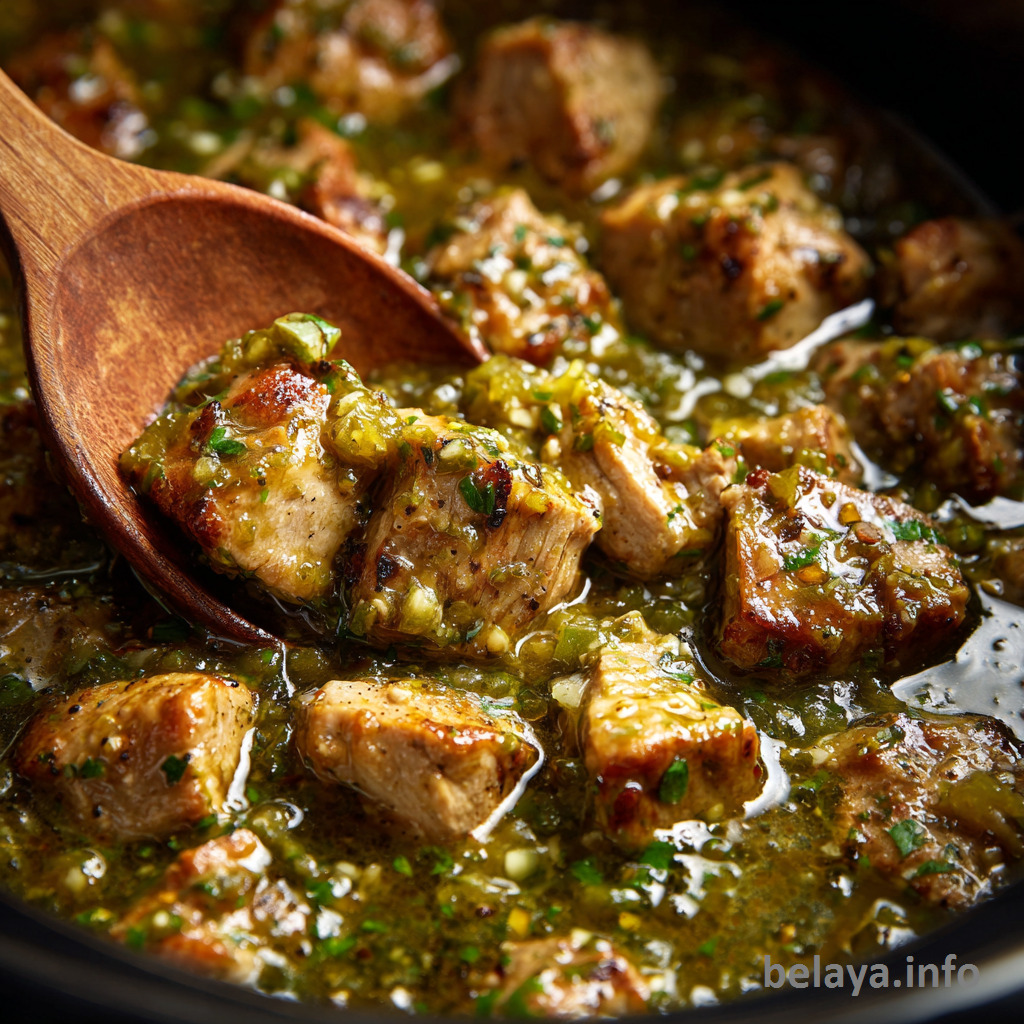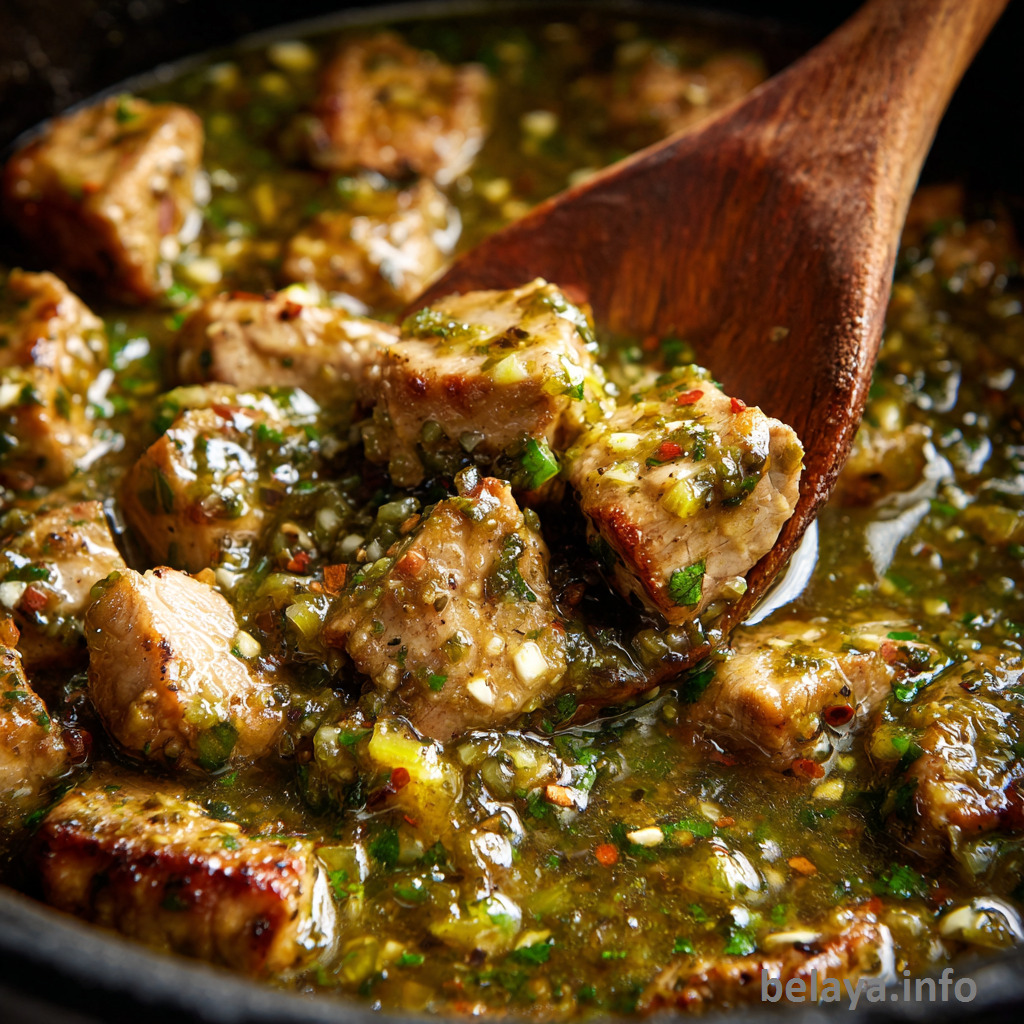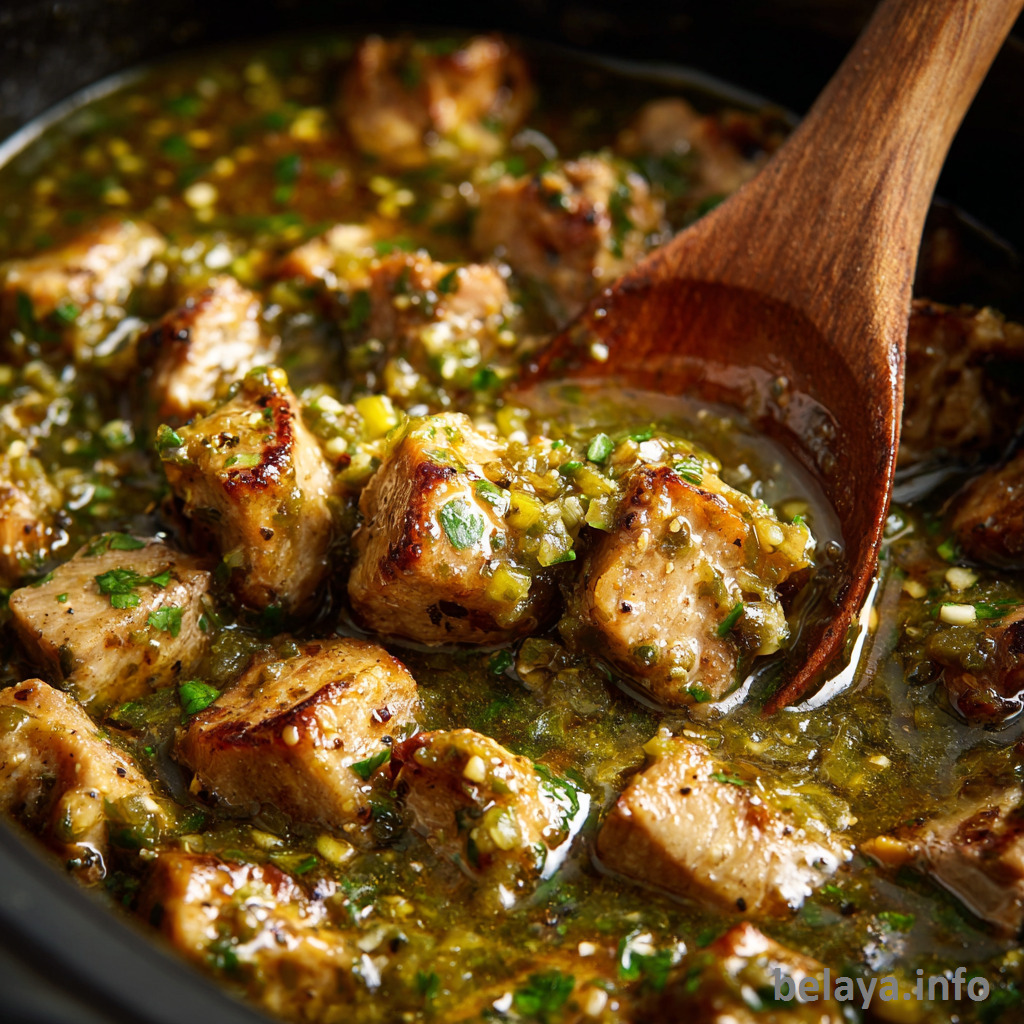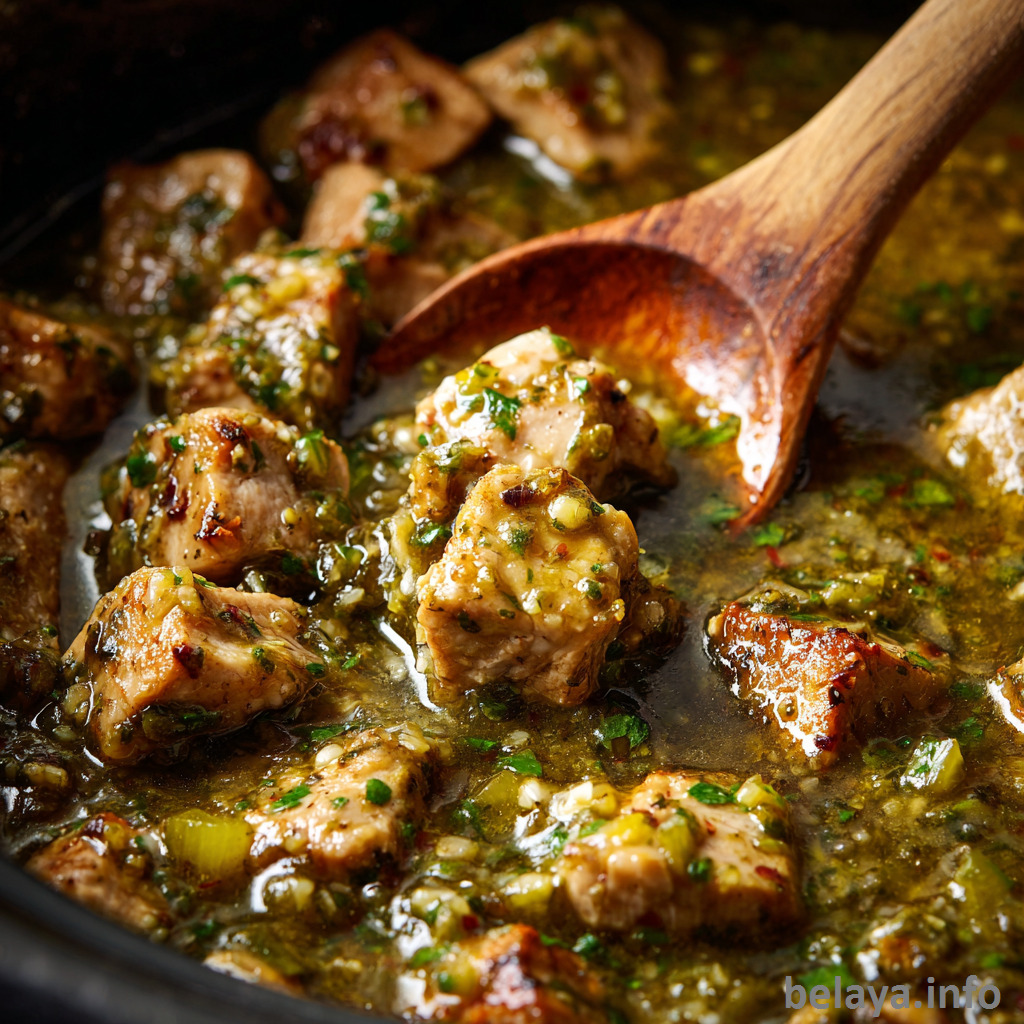Slow Cooker Chile Verde
Rich, bold, and soul-warming, this Slow Cooker Chile Verde is a celebration of traditional Mexican flavors elevated by a slow, gentle cook.
Tender cubes of pork shoulder soak up a vibrant salsa verde made from charred tomatillos, peppers, onions, and garlic—blended to perfection with fresh cilantro and warm spices.
The long, slow simmer allows the flavors to meld into a deeply savory and tangy stew that’s as comforting as it is complex. It’s a dish that’s rustic in spirit, yet refined in depth—perfect for cozy gatherings or an impressive weeknight dinner.

Why People Will Love This Slow Cooker Chile Verde Recipe:
Melt-in-your-mouth texture: The slow-cooked pork shoulder becomes incredibly tender and succulent after simmering for hours, delivering that fall-apart goodness in every bite.
Complex, smoky flavor: Roasting the tomatillos, peppers, garlic, and onion before blending gives the salsa verde a rich, deep flavor with charred undertones that can’t be rushed or replicated.
Balanced heat and brightness: The combination of spicy jalapeños, fresh tomatillos, and citrusy cilantro creates a vibrant sauce that’s both warming and refreshing—never one-note.
Hands-off convenience: Once everything is prepped and in the slow cooker, the dish takes care of itself, making it ideal for busy weeknights, meal prepping, or impressing guests with minimal stress.
Endlessly versatile: Serve it over rice, in tacos, with tortillas, or alongside beans—this dish adapts beautifully to different meals and tastes, offering comfort and authenticity in every form.

Key Ingredients:
Pork Shoulder: Richly marbled with fat, this cut becomes luxuriously tender during slow cooking. It absorbs the bold, tangy flavors of the verde sauce while providing hearty, meaty depth.
Tomatillos: The soul of the salsa verde, tomatillos bring a naturally tart, citrusy brightness that cuts through the richness of the pork and balances the smoky roasted peppers.
Poblano and Anaheim Peppers: These mild, earthy chiles add subtle heat and roasted complexity. When charred, they lend a deep umami layer to the sauce without overpowering the palate.
Jalapeños: For those who enjoy a kick, jalapeños bring controlled heat and a green, peppery flavor that livens up the blend.
Fresh Cilantro: Its herbal freshness and slight citrusy undertone provide a clean finish that lifts the heavier elements of the dish, making every bite feel vibrant and complete.
Cumin and Oregano: These two seasonings round out the flavor with earthy, aromatic depth—classic Mexican tones that complement the pork and peppers beautifully.

Expert Tips:
Char the vegetables properly: Don’t just roast—blister the peppers, tomatillos, and onions deeply until blackened in spots. This caramelization adds smoky undertones and intensifies the flavor of the salsa verde.
Use pork shoulder, not loin: Pork shoulder’s marbling and connective tissue break down during slow cooking, creating a succulent, fall-apart texture. Leaner cuts will turn dry and stringy.
Deglaze for extra flavor: After searing the pork, deglaze the skillet with a splash of chicken broth or water to lift the fond (brown bits) stuck on the pan. Pour that into the slow cooker—it’s flavor gold.
Leave the lid closed: As tempting as it is, resist lifting the lid during cooking. Each peek releases steam and heat, which can extend cooking time and dry out the pork.
Blend to your texture preference: For a rustic dish, pulse the salsa verde briefly to keep it chunky. For a more refined version, blend until completely smooth. You can even strain it for an ultra-silky sauce.
Finish with acid: Right before serving, a squeeze of fresh lime juice wakes up the dish and balances the richness of the pork and slow-cooked vegetables.
Let it rest before serving: Give the chile verde 10–15 minutes to settle after cooking. This allows the flavors to meld and the sauce to thicken slightly for a better mouthfeel.

Slow Cooker Chile Verde
Ingredients
3 pounds pork shoulder, trimmed of excess fat and cut into bite-sized cubes
2 tablespoons cooking oil (such as vegetable or canola, just enough to sear the pork)
2 tablespoons all-purpose flour, for lightly dredging the pork
2 poblano peppers, whole
2 Anaheim peppers, whole
2 jalapeño peppers, whole (remove seeds for less heat if desired)
4 cloves garlic, peeled
6 fresh tomatillos, husks removed and rinsed
1 large white onion, peeled and quartered
1 bunch fresh cilantro, thick stems trimmed, leaves loosely packed
¾ teaspoon salt, or to taste
¼ teaspoon freshly ground black pepper
½ teaspoon ground cumin
½ teaspoon dried oregano
1 cup low-sodium chicken broth, for blending and braising
Instructions
Step 1: Roast the vegetables
Preheat your oven to 450°F (232°C).
On a baking sheet, arrange the poblano peppers, Anaheim peppers, jalapeños, tomatillos (husks removed), garlic cloves, and quartered onion in a single layer.
Roast in the oven (2 racks below the broiler) for 20–25 minutes, or until the vegetables are nicely blistered and charred.
Watch closely to prevent burning.
Let them cool slightly before blending.
Step 2: Blend the salsa verde
Transfer the roasted vegetables to a blender.
Add the fresh cilantro (stems mostly removed) on top.
Blend until you reach your desired salsa consistency—smooth or slightly chunky.
If it’s too thick, add a bit of the chicken broth to help it blend smoothly.
Step 3: Prepare the pork
Toss the cubed pork shoulder in all-purpose flour until evenly coated.
In a large skillet over medium-high heat, add enough oil to lightly coat the pan.
Sear the pork in batches (don’t overcrowd the pan) until browned on all sides.
You don’t need to cook it through—just develop color and flavor.
Step 4: Assemble in the slow cooker
Place the browned pork in the slow cooker.
Pour the prepared salsa verde over the meat.
Add in the salt, pepper, cumin, oregano, and chicken broth.
Stir gently to combine.
Step 5: Slow cook to perfection
Cover and cook on LOW for 9 hours.
Do not lift the lid during cooking to preserve moisture and heat.
Step 6: Serve and enjoy
Serve the chile verde warm over rice, tortillas, or with a side of beans.
Top with lime wedges, sour cream, avocado slices, or chopped onions if desired.

Important Notes When Making Slow Cooker Chile Verde:
Roasting is non-negotiable: Roasting the tomatillos, peppers, onion, and garlic is essential. This step adds depth, smokiness, and a natural sweetness that you won’t get from raw ingredients or canned sauces.
Choose the right peppers: Poblano and Anaheim peppers offer mild heat and earthiness, while jalapeños bring brightness and spice. Adjust the number of jalapeños or remove seeds for a milder version.
Don’t skip the cilantro: It balances the richness of the pork with freshness and herbal notes. Use only the tender leaves and upper stems to avoid bitterness.
Use flour lightly: Tossing the pork in flour before searing helps with browning and slightly thickens the stew as it cooks—but overcoating or skipping this step can affect texture and consistency.
Searing matters: Searing the pork adds complex umami flavor through the Maillard reaction. Even though it takes time, don’t skip it—it’s a foundational step for flavor-building.
Do not overfill your blender: Hot roasted vegetables plus steam can cause pressure buildup. Blend in batches or vent the lid slightly with a towel for safety.
Low and slow is key: The 9-hour low cook time is ideal for breaking down pork shoulder. Cooking on high or cutting the time short will result in tougher meat and underdeveloped flavor.
Storage tip: This dish gets even better the next day. Store in an airtight container in the fridge for up to 4 days, or freeze for up to 2 months. Reheat gently to preserve texture.

How To Enjoy Slow Cooker Chile Verde After Cooking:
Choose Your Base
Warm tortillas: Scoop chile verde into soft, warm flour or corn tortillas for a comforting taco or burrito.
Steamed white or Mexican rice: Let the savory verde sauce soak into fluffy rice—it makes a hearty and satisfying bowl.
Crispy tostadas or tortilla chips: Turn it into a rustic appetizer or nacho platter by layering with cheese, crema, and toppings.
Add Bright & Creamy Toppings
To balance the rich, slow-cooked pork and roasted salsa:
A squeeze of lime: Brightens and lifts the dish.
Dollop of sour cream or Mexican crema: Adds cool creaminess that pairs beautifully with the heat.
Fresh chopped cilantro or scallions: Enhances the herbal notes and adds a pop of green.
Avocado or guacamole: Adds buttery richness and smooth texture.
Create a Complete Meal
Pair chile verde with:
Refried beans or charro beans
Grilled corn or elote
Pickled onions or jalapeños for contrast
Turn Leftovers into New Meals
Don’t let any go to waste—use leftovers creatively:
Chile Verde Enchiladas: Roll the pork in tortillas, top with verde sauce and cheese, then bake.
Chile Verde Breakfast Hash: Sauté with potatoes and top with fried eggs.
Stuffed Quesadillas: Sandwich the pork and cheese between tortillas and crisp until golden.
Serve Warm, Not Piping Hot
Let the chile verde rest for 5–10 minutes after cooking. This allows the juices to settle and the flavors to meld even more.
Pair with Drinks
Try with a cold Mexican lager, light beer, or a citrusy margarita.
For non-alcoholic options, serve with agua fresca, lime soda, or iced hibiscus tea (agua de jamaica).

Nutrition Information
For one serving (approximately 1 cup) of Slow Cooker Chile Verde:
Calories: 285 kcal | Total Fat: 16.4 g | Saturated Fat: 4.8 g | Monounsaturated Fat: 7.1 g | Polyunsaturated Fat: 1.6 g | Cholesterol: 80 mg | Sodium: 420–580 mg (depending on broth and added salt) | Total Carbohydrates: 7.4 g | Dietary Fiber: 2.1 g | Sugars: 3.2 g | Protein: 27.3 g

Frequently Asked Questions:
Can I use chicken instead of pork for this recipe?
Yes, boneless, skinless chicken thighs are a great substitute for pork shoulder. They stay moist during slow cooking and absorb the chile verde flavor beautifully. Reduce cook time slightly—about 6–7 hours on LOW.
How spicy is this chile verde, and how can I adjust the heat level?
This recipe has a medium kick due to the jalapeños and serrano-like flavor of the Anaheim peppers. To reduce heat: deseed all peppers or omit the jalapeños. For more heat, leave seeds in or add an extra chili like serrano or habanero.
Can I prepare the salsa verde ahead of time?
Absolutely. You can roast and blend the salsa verde up to 3 days in advance. Store it in an airtight container in the fridge. This can make prep day much faster and still deliver great flavor.
Is it necessary to sear the pork before adding it to the slow cooker?
While not required, searing adds depth of flavor and helps seal in juices. It creates a caramelized exterior that elevates the overall richness of the dish. For a shortcut, skip it—but the flavor payoff is worth the extra step.
What are the best ways to serve and use leftovers?
Serve chile verde over rice, in tacos, burritos, or with warm tortillas. Leftovers can also be repurposed into enchilada fillings, quesadillas, or topped on nachos. It also freezes well for up to 3 months—perfect for batch cooking!
What’s the best cut of pork to use, and can I use leaner cuts?
Pork shoulder (also known as pork butt) is ideal because its marbling ensures tenderness after long, slow cooking. You can use pork loin or tenderloin for a leaner version, but they may turn out slightly drier unless monitored closely and cooked for a shorter time.
Why do I need to roast the vegetables before blending the salsa?
Roasting caramelizes the sugars in the tomatillos, onions, and peppers, giving the salsa a deep, smoky complexity. Skipping this step would result in a more raw, acidic flavor. The char also enhances color and aroma in the final dish.
Can I make this recipe without a blender?
Yes. If you don’t have a blender, you can finely chop the roasted vegetables by hand or use a food processor for a chunkier texture. The flavor will still be delicious, though the sauce may be slightly less smooth.
Should I toast the flour on the pork before searing it?
Coating the pork in flour before searing helps develop a crust, which not only enhances browning but also slightly thickens the sauce as it cooks. If you want a thinner broth, you can skip the flour without compromising too much flavor.
Can I use a pressure cooker or Instant Pot instead of a slow cooker?
Yes, the Instant Pot is a great alternative. After searing the pork using the sauté function, pressure cook on HIGH for about 45 minutes with a natural release. This drastically reduces cook time while maintaining tenderness and flavor depth.